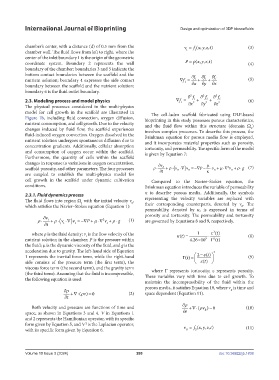Page 288 - IJB-10-3
P. 288
International Journal of Bioprinting Design and optimization of 3DP bioscaffolds
chamber’s center, with a distance (d) of 0.5 mm from the v = f xy zt(, ,, ) (3)
chamber wall. The fluid flows from left to right, where the 1 1
center of the inlet boundary 1 is the origin of the geometric
coordinate system. Boundary 2 represents the wall P = p xy zt(, ,, ) (4)
boundary of the chamber; boundaries 3 and 5 indicate the
bottom contact boundaries between the scaffold and the ∂f ∂f ∂f
nutrient solution; boundary 4 expresses the side contact ∇=f i i + i + i (5)
boundary between the scaffold and the nutrient solution; ∂x ∂y ∂z
boundary 6 is the fluid outlet boundary.
2
2
∂ f ∂ f ∂ f
2
f
i
2.3. Modeling process and model physics ∇= ∂x 2 i + ∂y 2 i + ∂z 2 (6)
i
The physical processes considered in the multi-physics
model for cell growth in the scaffold are illustrated in The cell-laden scaffold fabricated using DLP-based
Figure 1b, including fluid convection, oxygen diffusion, bioprinting in this study possesses porous characteristics,
nutrient consumption, and cell growth. Due to the velocity and the fluid flow within this structure (domain Ω )
1
changes induced by fluid flow, the scaffold experiences involves complex processes. To describe this process, the
fluid-induced oxygen convection. Oxygen dissolved in the Brinkman equation for porous media flow is employed,
nutrient solution undergoes spontaneous diffusion due to and it incorporates material properties such as porosity,
concentration gradients. Additionally, cellular absorption tortuosity, and permeability. The specific form of the model
and consumption of oxygen occur within the scaffold. is given by Equation 7:
Furthermore, the quantity of cells within the scaffold
changes in response to variations in oxygen concentration, ∂v µ
ρ g (7)
ρ v
2
scaffold porosity, and other parameters. The four processes ρ ⋅ ∂t B +⋅( B ⋅∇)v B =−∇−P κ ⋅v B + µ ⋅∇ v B +⋅
are coupled to establish the multi-physics model for
cell growth in the scaffold under dynamic cultivation Compared to the Navier–Stokes equation, the
conditions. Brinkman equation introduces the variable of permeability
2.3.1. Fluid dynamics process κ to describe porous media. Additionally, the symbols
The fluid flows into region Ω with the initial velocity v , representing the velocity variables are replaced with
1
0
which satisfies the Navier–Stokes equation (Equation 1): their corresponding counterparts, denoted by v . The
B
permeability, denoted by κ, is expressed in terms of
ρ ⋅ ∂v 1 ρ v ⋅∇)v =−∇+P µ ⋅∇ v +⋅ (1) porosity and tortuosity. The permeability and tortuosity
2
ρ g
are governed by Equations 8 and 9, respectively.
∂t +⋅( 1 1 1
3
where ρ is the fluid density; v is the flow velocity of the κ()t = 1 ⋅ ε () t (8)
1
nutrient solution in the chamber; P is the pressure within . 42610 9 Γ 2 ()t
×
the fluid; µ is the dynamic viscosity of the fluid, and g is the
acceleration due to gravity. The left-hand side of Equation 2
1 represents the inertial force term, while the right-hand Γ()t = 2 −ε ()t (9)
side consists of the pressure term (the first term), the ε ()t
viscous force term (the second term), and the gravity term where Γ represents tortuosity; ε represents porosity.
(the third term). Assuming that the fluid is incompressible, These variables vary with time due to cell growth. To
the following equation is used:
maintain the incompressibility of the fluid within the
porous media, it satisfies Equation 10, where v is time and
∂ρ B
+∇⋅ ρv( ) = 0 (2) space dependent (Equation 11).
∂t
∂ρ
Both velocity and pressure are functions of time and +∇⋅ ρv( B ) = 0 (10)
space, as shown in Equations 3 and 4. ∇ in Equations 1 ∂t
and 2 represents the Hamiltonian operator, with its specific
2
form given by Equation 5, and ∇ is the Laplacian operator, v = f xy zt(, ,, )
with its specific form given by Equation 6. B 2 (11)
Volume 10 Issue 3 (2024) 280 doi: 10.36922/ijb.1838

